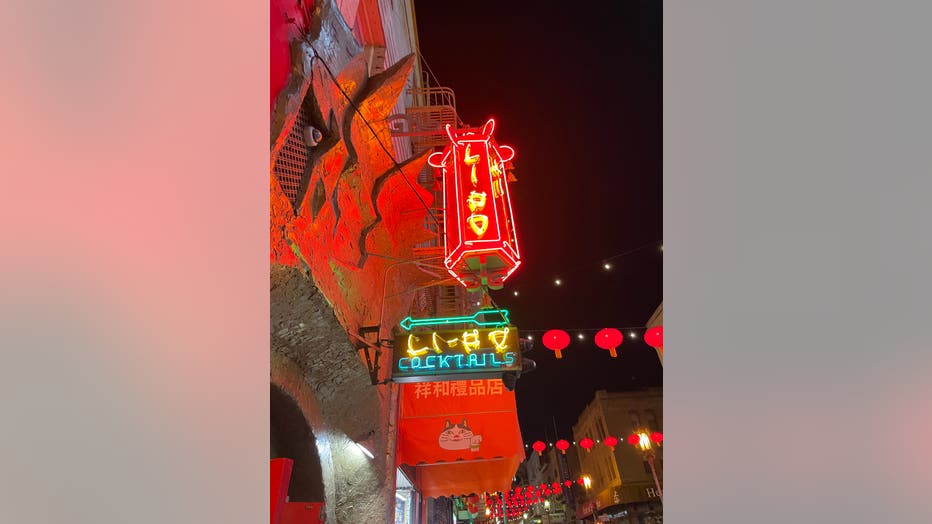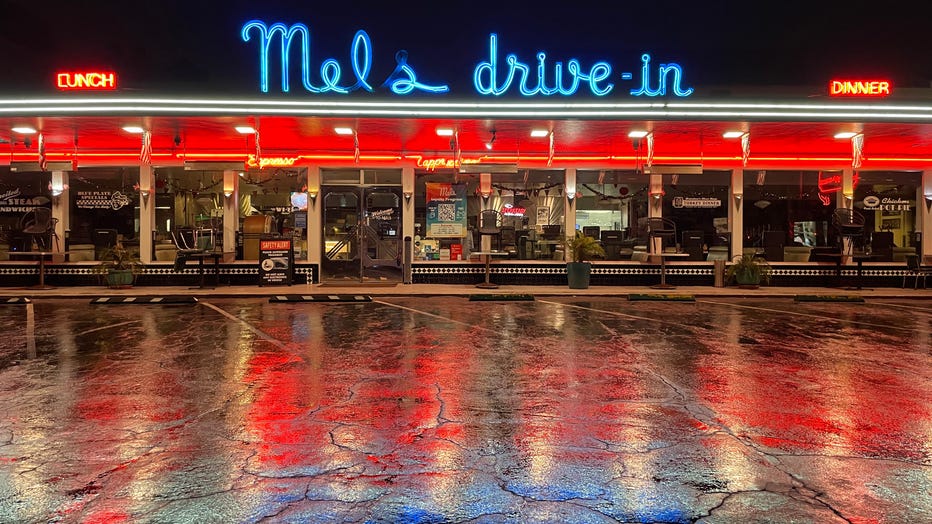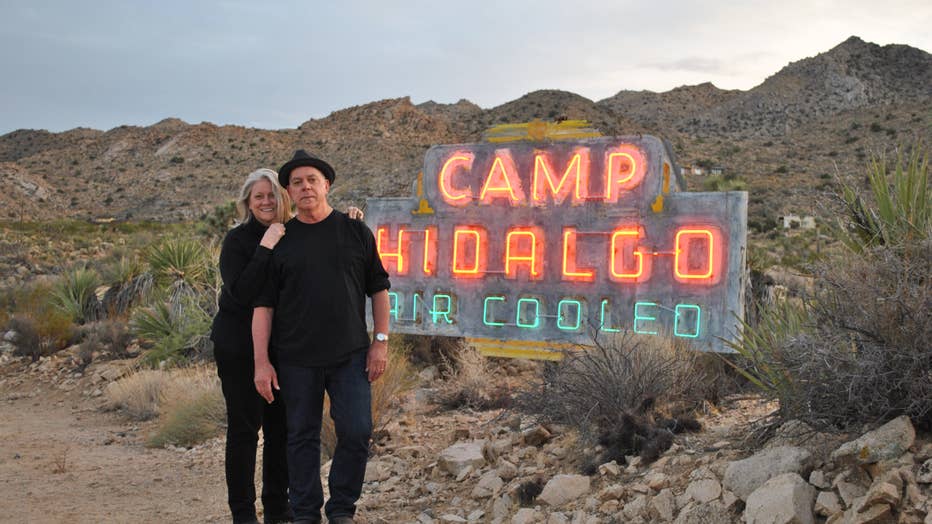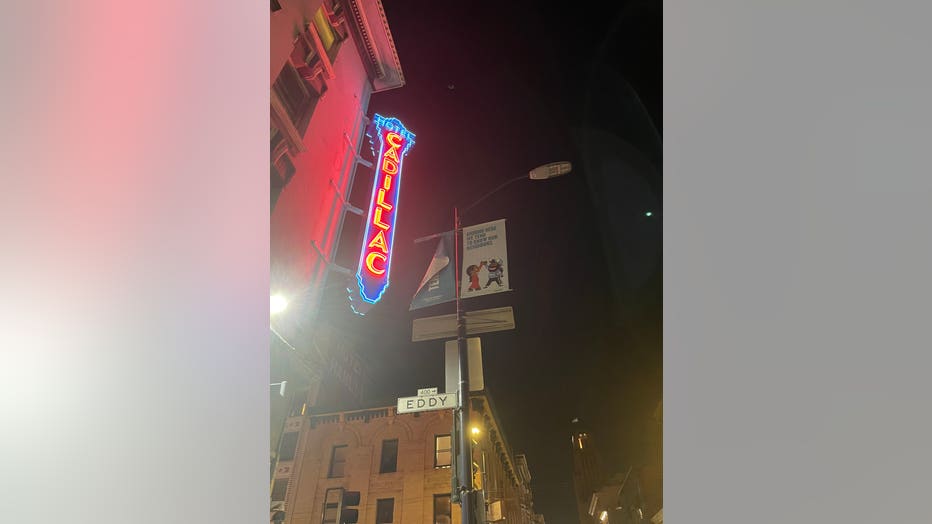San Francisco neon lights: A luminous trip through time

San Francisco neon lights: A luminous trip through time
If you've ever basked in the warm glow of a neon sign, you'd know the attraction to the light is something unique. We've highlighted San Francisco's vibrant neon signs and it's like taking a trip through time. We also to see how the signs are made at Oakland's Neon Works.
SAN FRANCISCO - "It's like trying to hold a wet noodle straight," says Adam Taylor, a glass bender at Oakland's Neon Works.
He's been bending neon into shape for seven years, but has only been good at it for three, he says.
If you've ever basked in the warm glow of a neon sign, you'd know the attraction is much like a moth to a flame, but also eerily inexplicable. In San Francisco, there is a trove of neon signs and a resurgence of interest in the historical lights, exemplified by several tours to some of the bright spots around town.
Taylor, at his workplace warehouse, demonstrates his skill by creating a neon Christmas tree.
While holding a wet noodle straight sounds difficult, he says he's been at his craft long enough that it's fun for him.
"It is very meditative. You do get kind of lost in the task as far as just one step at a time," Taylor says. "It's really great at honing my focus and attention and I love that aspect to it. It's such a unique skill."
With understated confidence, he's able to explain each step of the way; simultaneously speaking with a silicon tube in his mouth like it's nothing. This part of his workflow resembles someone puffing on a hookah.
But he never loses focus as he works near open flames – an integral part of the process.
"To glass bend, I have to heat up the tube until it gets molten and then when that happens, it makes the heat want to shrink in," says Taylor.
In a way, he breathes life into the glass, blowing tiny puffs of air into the tube, so it doesn't collapse on itself.
"That keeps the round shape so that once it's processed, the gas and electricity can flow through nicely and uninterrupted," Taylor says.
San Francisco's neighborhoods are saturated with neon signs, each illuminating with its own one-of-a -kind ambiance. Taylor says it's fun being out in the city or "driving down the street and saying or thinking to himself, ‘Oh I made that.' Or, 'That’s where that went.'"
The group San Francisco Neon curates six neon light tours throughout the city. Al Barna, one of the partners of the nonprofit organization, says they advocate, particularly for vintage classic neon signage, through education, restoration and preservation.
"I'm very interested in the history of the businesses behind the signs. Most of the signs in San Francisco are from smaller businesses; mom and pop businesses," says Barna.
Light of their lives
So what is the inexplicable attraction?
"It's the quality of the light. It's fairly unique. It's not like any other light source," Barna says.
Randall Ann Homan, the co-founder of San Francisco Neon, says neon is a particularly beautiful ambient light.
"The 500 Club in the Mission is the most sparkling neon sign in San Francisco and definitely the biggest cocktail glass neon sign in the city, maybe anywhere," Homan says.
She loves the combination of animated bulbs with the neon cocktail glass. "It just transforms that corner. It's just the most celebratory neon sign in the city."
Across the Bay, Jim Rizzo, owner of Oakland's Neon Works, sums up this unique quality that has drawn in so many over the years.
"Nothing can compare. I don't know how else to describe the energy to it. It takes fire and glass and then you charge it with high voltage. And then you fill it with gas," Rizzo says. "I don't know…it's just really cool. I don't think it will ever go away."
Neon's heyday
Neon was introduced in the United States in 1923. Barna says by most accounts, neon's golden era was through the 1930s and 1940s; yet its vibrant glow carried well past World War II and into the 1950s.
Taylor learned his trade at an art school – New York's Alfred University.
Surprisingly, aside from slight improvements, the techniques and the equipment used to make neon signs haven't really changed after 100 years.
Taylor is keenly aware of a neon sign's potential longevity, because he's worked with the materials that are built to last.
"If it's made correctly, it can last decades," says Taylor. With proper maintenance and refurbishing, signs can last 50 to 70 years, or more.
Take the sign at Chinatown's Li Po Lounge, for example. It's 80 years old. It can be seen in the movie, "Lady From Shanghai," which was filmed in 1946.
Homan says this sign is a "must see."
"I think the signs of Chinatown are the most unique because, one, they're bilingual, which is beautiful. Li Po is such a special sign because it's got that sculptural quality. It's 3-D," Homan says.
She says a neon sign's paint needs to be scraped back to the bare metal to be repainted every 10-20 years, like a house or a classic vintage car.
"The paint is what really preserves the metal cabinet or sign," she says. Typically, these are made from good sheet metal that will last long with proper maintenance.

San Francisco Chinatowns Li Po Lounge. November 2023.
Tenderloin a bright spot
The Tenderloin, often characterized as forlorn, has long been associated with neon signage. Barna says a survey there found more than 120 neon signs. That's more neon signage in one neighborhood than any other neighborhood in the U.S., according to Homan.
Something that makes the Tenderloin unique is its many residential signs, some of which are connected to the rebuilding of the city after the great 1906 earthquake.
The Ambassador Hotel and The Cadillac Hotel have prominent vintage neon signs. The Jefferson Hotel and the Kinney Hotel were built right after the earthquake with people inhabiting them as early as 1907. The hotels provided living space for workers who helped rebuild San Francisco.
"So the Elm Hotel, The Senator Hotel, [and] The Cadillac Hotel…these hotels still have their signs, and they really represent the people who live here, not just the businesses, and we love that," says Homan.
The Cadillac Hotel is the site of the city's newest neon sign, dedicated in November. The 25-foot double-sided sign was a collaborative effort between San Francisco Neon and the Tenderloin Museum. It stands inside the recently designated neon sign district. The designation eases zoning restrictions in the Tenderloin, making it easier to refurbish historic signs and install new ones.
One notable sign in this neighborhood sits at the corner of Hyde and O'Farrell streets.
"One of my favorite signs is the Nite Cap," says Homan. "It has a little emblem, the sleeping moon on the top of it and great letter forms."

Porcelain neon sign for San Francisco Tenderloin's Nite Cap.
The sign is made of porcelain. "Porcelain signs are the real special ones. They don't have many in San Francisco." Homan says these signs have a reflective quality and involved the best designers. "The ones we have are still bright and beautiful."
Signs with soul
Neon signs are seen as both an art form and historical artifacts. For some, their preservation is of the utmost importance.
Homan says San Francisco's neon signs are just as significant as an art collection in any museum.
"We don't need a big museum for the Bay Area if we can keep these signs on the street where the public can see them," says Homan. And that's the group's ultimate goal. "For every neon sign, there's a legacy of mom-and-pop businesses behind the sign."
There's now a trend for historical preservation. But for Homan, it doesn't stop there. "Don't save just the sign. Save the business. Save the people and the community around that business."

The neon signage at Mel's Diner in San Francisco's Richmond District. December 1, 2023. (Photo: Andre Torrez)
Rizzo, a self-professed "neon groupie" couldn't agree more. Oftentimes, these signs are ghosts of a business that once existed.
"I just loved neon and I used to hang out in neon shops and buy their mistakes for like 10 bucks and put it up in my apartment," says Rizzo.
He's been in business 33 years. His infatuation with neon led to him taking a class at a neon shop. After learning glass bending, he found a shop that would let him practice. He started moonlighting as a sign maker, picking up clients.
Eventually, he quit his day job and got his first warehouse. He's now in his third warehouse, but he doesn't bend neon anymore. He sticks to the business side of things in his small operation.
For Rizzo, the attraction is not only the light, but the history of the businesses behind the signs.

A sign for Kilpatrick's Bakeries.
He has a massive sign for Kilpatrick's Bakery, which produced bread for World War II soldiers, that once stood at 16th and Folsom streets.
In his warehouse, there are signs for the old Aquarius Records, San Francisco's Carl's Pastry, the former bakery where Tartine now stands, and Rexall Drugs, stored among other relics.
"A lot of people just wanna shop at CVS or something like that. I look at these old businesses and can feel like what happened in those places, like the people that worked at Aquarius Records or Bruno's Radio. You know…the family that raised their kids off of Kane's Furs or Bell Rexall…so to me, the history is really the most important thing," says Rizzo. "How many loaves of bread went through Kilpatrick's to feed the military of World War II? I mean…amazing."

Randall Ann Homan and Al Barna at Joshua Tree.
Hidden history
Homan says neon signs soak up community history. Once the business attached to the sign closes and the family or business owner has moved on, the community still has a strong connection to the sign.
Her curiosity about the Golden Star Radio sign on Clay Street in Chinatown sparked her group to do some social media sleuthing to find building's owner. The sign represents the very first Chinese language radio station in North America.
"May-Chin Tong wanted to be a broadcaster so badly that her husband built a radio station for her to broadcast in Chinese," says Homan.
In the evening, Tong would read the news in Cantonese for KSAN and for other businesses. According to one website, Golden Star Radio aired the Chinese News Hour from 1939 to 1979. The broadcasts came from the building's basement below the family's appliance shop. The radio station is gone, but the building remains in the family as a tattoo parlor.
"It's a beautifully designed sign. It has a nested star that radiates. I'm sure it animated when they were broadcasting. That just has to be true," Homan says.

One side of the double-sided Cadillac Hotel sign in San Francisco's Tenderloin. November 2023.
Fading lights
"After (WWII), things just really went crazy. Everybody had money to spend. Most of the signs that you see out there are late ‘40s, early ’50s," says Rizzo. "The old one's like John's Grill…there's tons of ‘em. There used to be so much more."
He says if you look at old photos of Kearny and Market streets, and in Chinatown or along North Beach’s Broadway Street, you'd see hundreds of neon signs.
"I mean, back in the fifties, every block was covered with neon and obviously things changed," says Taylor.

Neon sign at John's Grill San Francisco. Dec. 6, 2023.
When materials like florescent tubing, acrylic and plastic became available to commercial sign makers, Barna says salespeople were able to convince business owners that they didn't need neon anymore. You could get your signage much cheaper by using florescent backlight tubing.
Neon slowly started disappearing and was being replaced by plastic signs.
There were actually nationwide campaigns to scrap old signs removed from buildings during this era's City Beautiful movement – a relic of urban planning's past.
"Urban flight kind of created situations where buildings and hotels, things with neon, weren’t in the most desirable part of town anymore," says Barna. Budgets to maintain signs went by the wayside. Letters burned out and the signs began to break and fail.
Finishing touches
Back at the Oakland warehouse, the lighting of Taylor's neon Christmas tree conjures images of a high-school chemistry lab with elements of Dr. Frankenstein jolting his monster to life. This final process is called bombarding. The conditions must be perfect. Art, science and engineering are all melded together to make neon signs.
The color of the sign is determined by the gas that fills the tube. Neon, by itself, produces red. But argon or mercury will engage the phosphors to create other colors, according to Taylor. "Most neon that's out on the streets, is actually argon and mercury. No neon involved," he says.
This neon community doesn't seem particular. It all goes under the umbrella of neon.
Flashing a smile, the tree he's created casts an evergreen glow. Taylor quips, "I've never met anyone who hates neon."

The neon sign at San Francisco's Castro Theatre, considered the crown of the city.

